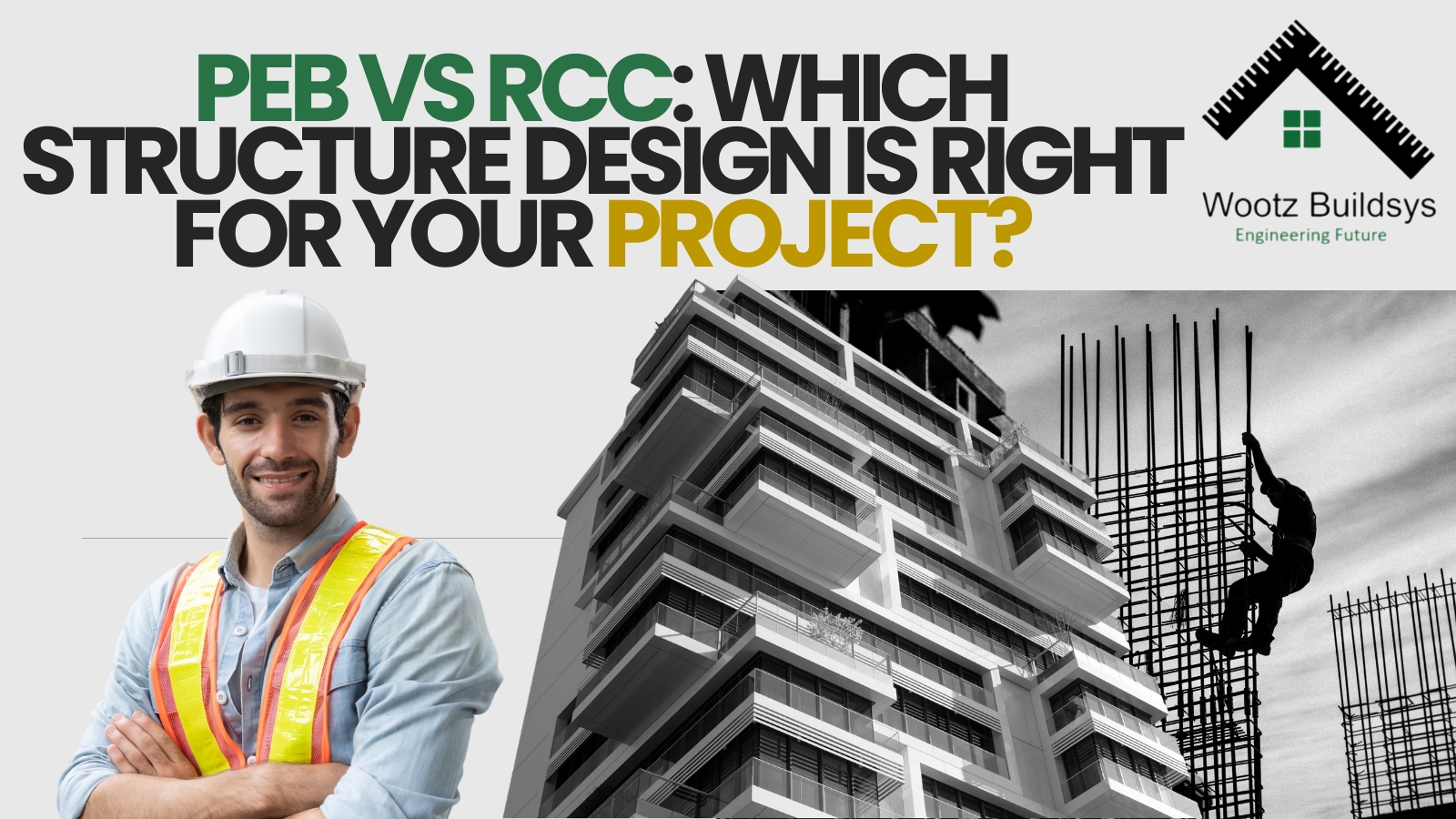
Choosing the right structural system can define the success of your construction project—whether it’s a factory, warehouse, commercial building, or even residential housing. Among the most common options in India today are PEB structure design and RCC (Reinforced Cement Concrete) construction.
But which one is better suited for your project?
In this in-depth comparison, we’ll explore the differences between PEB and RCC in terms of cost, speed, flexibility, sustainability, and use cases—so you can make an informed, strategic decision.
What Is a PEB Structure Design?
PEB stands for Pre-Engineered Building. In a PEB structure design, the building components (columns, beams, roofing, wall panels, etc.) are custom-designed, pre-fabricated in a factory, and assembled on-site.
This type of structure is most commonly made of steel and is widely used for:
- Industrial sheds
- Warehouses
- Logistics parks
- Aircraft hangars
- Cold storage facilities
PEB structure design emphasizes:
- Speed of construction
- Lightweight steel components
- Modular, scalable systems
- Cost control through factory precision
What Is RCC Construction?
RCC, or Reinforced Cement Concrete, is the traditional method of construction in which steel bars (rebars) are embedded into cast-in-place concrete for added strength.
It’s commonly used for:
- Residential and commercial buildings
- Bridges and dams
- Infrastructure and civic projects
- Foundations and basements
RCC construction is known for:
- High compressive strength
- Long-term durability
- Familiarity across India’s contractor base
- On-site flexibility during execution
PEB vs RCC: Head-to-Head Comparison
Let’s break it down across key criteria to see which structure suits your project goals best.
1. Construction Speed
- PEB: Extremely fast. Since parts are manufactured off-site, on-site time is limited to assembly. This reduces total project duration by 40–60%.
- RCC: Slower. Needs shuttering, curing, and weather-based delays. Can take 2x longer than PEB for the same size building.
Winner: PEB
2. Cost Efficiency
- PEB: Lower labor cost, less material waste, and faster returns due to quicker operation. Initial material cost may seem higher, but total cost is often lower.
- RCC: More cost-effective for small to mid-size buildings, but becomes more expensive and slower for larger spans or high-rise structures.
Winner: PEB for large/industrial projects; RCC for small-scale buildings
3. Design Flexibility
- PEB: Modular but can be customized. Limited to certain design styles and geometry due to steel fabrication constraints.
- RCC: Highly flexible in shape, layout, and architecture. Great for custom or irregular designs.
Winner: RCC for design complexity; PEB for modular efficiency
4. Structural Performance
- PEB: Excellent tensile strength, earthquake resistance, and load-bearing capacity for wide spans without columns.
- RCC: Better compressive strength. Heavier structures can be more stable in vertical construction but may need deep foundations.
Winner: Tie (depends on the use case)
5. Durability and Maintenance
- PEB: Resistant to pests, mold, and corrosion (if coated well). Requires periodic maintenance like painting or bolt tightening.
- RCC: Highly durable and low-maintenance once constructed but can suffer from seepage or cracking over time.
Winner: RCC (for long-term durability); PEB (with proper care)
6. Sustainability
- PEB: More sustainable. Steel is 100% recyclable, and factory production reduces site waste and pollution.
- RCC: Produces more dust, noise, and waste. Cement production is also energy-intensive.
Winner: PEB
7. Skilled Labor Availability
- PEB: Requires trained labor for erection and bolting, which may not be readily available in remote areas.
- RCC: Traditional method; contractors and masons across India are familiar with it.
Winner: RCC
When to Choose PEB Structure Design
PEB is your best choice if:
- You need fast and cost-effective construction
- Your project is industrial, commercial, or modular in nature
- You’re working with large clear spans (e.g., warehouse or hangar)
- Sustainability and low maintenance are priorities
- Your site access and foundation conditions allow for steel structures
Examples:
- Logistics parks
- Cold storage buildings
- Assembly-line factories
- Indoor stadiums
When to Choose RCC Construction
RCC is better suited if:
- You require custom architecture or multi-story designs
- Skilled PEB labor is not available at your project site
- Your design must incorporate heavy loads or underground basements
- The budget is tight and construction can take more time
- Building codes or zoning require RCC (e.g., in some residential zones)
Examples:
- Apartment complexes
- Hospitals and schools
- Flyovers and bridges
- Low-rise housing in rural areas
PEB + RCC: Hybrid Options
Some developers are exploring hybrid systems that use PEB structures with RCC cores or foundations. This allows you to enjoy the speed and modularity of PEB while ensuring vertical stability and compliance with local codes using RCC.
This is particularly effective for:
- High-rise industrial buildings
- Mixed-use developments
- Offices with RCC cores and steel-framed exteriors
At Wootz, we specialize in hybrid structural solutions that combine the best of both worlds. Our expertise in PEB structure design and RCC engineering allows us to deliver projects that are faster, smarter, and more durable.
Final Thoughts
There’s no universal winner in the PEB vs RCC debate. Your ideal choice depends on:
- Project size and function
- Construction timeline
- Budget and location
- Sustainability goals
- Regulatory environment
If speed, efficiency, and scalability are your priorities, PEB structure design is the modern answer. For complex, custom-built spaces or traditional high-load environments, RCC still holds strong.
Need expert advice?
Talk to our engineers at Wootz to determine the right structural system for your project. Whether it’s PEB, RCC, or a hybrid solution, we’ll guide you every step of the way.
Frequently Asked Questions (FAQ’s )
1. What is the difference between PEB and RCC?
PEB (Pre-Engineered Building) uses prefabricated steel components assembled on-site, while RCC (Reinforced Cement Concrete) involves casting concrete with steel reinforcements on-site. PEB is faster and modular; RCC is more traditional and versatile in design.
2. Is PEB cheaper than RCC construction?
PEB can be more cost-effective for large-scale industrial and commercial buildings due to faster construction, lower labor costs, and less material waste. RCC may be cheaper for small residential structures.
3. Which is more durable: PEB or RCC?
Both are durable when designed properly. RCC offers excellent compressive strength and long-term stability. PEB, when coated and maintained, is resistant to corrosion and has high tensile strength.
4. Is PEB structure good for residential buildings?
Yes, PEB can be used for residential structures, especially villas and low-rise modular homes. However, RCC is still preferred for multi-story housing in urban areas due to code familiarity and design flexibility.
5. How long does it take to construct a PEB building?
PEB structures can be erected in 30–50% less time than traditional RCC buildings due to off-site fabrication and rapid on-site assembly.
6. Is PEB suitable for seismic zones?
Yes. PEB structures are ideal for seismic zones because steel frames are lighter and more ductile, which helps absorb seismic forces better than heavy concrete.



